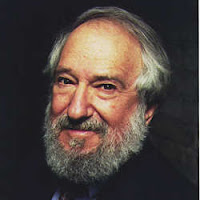Wittgenstein and Vygotsky are worth examining in relation to Generative AI, as their views on language are, I think, very relevant to the use of language to teach and learn. Another theorist who comes to mind is the South African, Seymour Papert.
Papert, unlike most learning theorists, was a mathematician and expert in AI and cowrote, with Marvin Minsky, the influential book 'Perceptrons' (1969)). I did a podcast on this early work on neural networks). He co-founded the Artificial Intelligence Lab at MIT with Marvin Minsky, and was a founding faculty member of the MIT Media Lab. He also co-founded the Epistemology and Learning Group at the MIT Media Lab, which explored the intersection of AI and education with a focus on the development and application of educational technologies, including AI-based tools, to enhance learning. Their work contributed to the development of intelligent tutoring systems, simulations, and learning environments that leveraged AI techniques to support learners. He dies in 2016 and is someone worth listening to.
Mindstorms
In his book ‘Mindstorms: Children, Computers, and Powerful Ideas’ (1980) he explored the potential of computers and AI for educational purposes. Children could use computers as ‘mindstorms’ to engage in creative problem-solving, discover mathematical concepts, and develop a deeper understanding of various subjects. He saw AI as providing personalised and student-centered learning, allowing them to pursue their individual interests and learn at their own pace. He believed that AI technologies could adapt to studentss' needs, provide tailored feedback, and offer opportunities for meaningful exploration and discovery. Papert also emphasized the importance of social and emotional aspects of learning. He believed that AI technologies could also facilitate collaborative learning, foster social interactions, and support the development of emotional intelligence. Generative AI is now delivering on that promise.
Constructionism
For Papert, computers and the web are not merely tools but ways of thinking, in the same way that writing is a way of thinking and expression. In 'The Children’s Machine' (1993) he promoted ‘concrete’ learning as he saw the teaching of purely abstract knowledge as hopelessly imbalanced (I agree). It is not that the computer teaches the child but that the child uses the computer to learn. Instruction, he thought, should be replaced by construction. With Generative AI, and ChatGPT, our relationship with knowledge changes from a search and retrieve model or presentation through lectures, PowerPoint and page turning e-learning, towards dialogue. He would, I’m sure, have approved.
He had worked with Piaget and certainly saw learning as a constructivist process but had stronger views on learning by doing. He promoted ‘Constructionism’ because he believed that learners actively construct their own knowledge by engaging in hands-on, meaningful activities and by creating and manipulating objects in the external world and AI could provide learners with tools and environments for exploration, experimentation and creation. This is why he went on to create LOGO, a computer language for computer control by learners.
Knowledge Machine
As part of his constructionist vision, he speculated that a ‘Knowledge Machine’ could be built that takes anyone, especially children, into a learning environment, where they can interact, problem solve and develop. His knowledge machine predicted the virtual environment that appeared as the web and the move from 2D towards 3D virtual learning worlds, such as computer games, Minecraft, AR and VR. In this he was prophetic, as the web produced devices and resources that were almost unimaginable when Papert first realised this idea. Generative AI is also in the process of making avatars, with speech recognition, eye-tracking, within 3D worlds, with AI guided learning pathways to make learning in context much easier. He was, in this sense, prophetic.
Low floor, high ceiling
Papert made an interesting contribution to technology used for learning in proposing his 'Low floor, high ceiling' idea, where the tool is super-easy to use (ChatGPT) yet has lots of headroom in terms of functionality and efficacy. This is why he would have loved Generative AI. It explains the popularity of search - simply type into a box, it also explains why hundreds of millions are using generative AI - fiendishly easy to use with mind blowing functionality, productivity and potential.
Conclusion
Seymour Papert thought deeply about AI and learning. He saw AI as a powerful tool that could transform education and learning and was an advocate for integrating AI and technology into the process of learning. In particular, he saw AI technologies as providing personalized learning experiences that empower students, and facilitate deep engagement with the subject matter. He would have been overjoyed at the current interest in Generative AI as both proof that he was right and, as an active socialist in South Africa, would have relished the opportunity to use the technology for good.

No comments:
Post a Comment